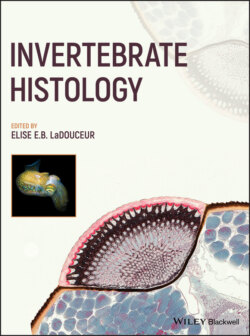Читать книгу Invertebrate Histology - Группа авторов - Страница 22
1.3.7 Respiratory System
ОглавлениеEchinoderms have limited anaerobic capacity and are very sensitive to oxygen availability. Gas exchange with the water vascular system occurs through the tube feet in all echinoderms. To enhance gas exchange to the coelomic viscera and muscles of the disc and rays, all echinoderms except crinoids also have specialized evaginations of the coelomic epithelium, which extend through or between the endoskeletal plates of the body wall to the external body surface and function as “gills.” Gas exchange via diffusion occurs between the external sea water and internal coelomic fluid across the extremely thin body wall.
Figure 1.22 Tiedmann's body in a mottled star. 100×, HE.
Figure 1.23 Histology of gills (papulae) in a white urchin showing epidermal surface (E), supported by connective tissue (Ct), and a central lumen lined by coelomic epithelium (C). 200×, HE.
In asteroids these evaginations of the body wall are called papulae. They can be branched and in species with paxillae, the papulae typically sit in the water‐filled branchial space beneath this umbrella‐shaped specialized surface structure. In regular echinoids there are five pairs of peristomial gills on the peristomial membrane, at the margin of each interambulacral plate, that likely provide gas exchange for the muscular apparatus of the lantern. These originate as evaginations from the peripharyngeal (lantern) coelom and have similar histologic features to asteroid papulae. Coelomic fluid is pumped to and from the peristomial gill lumen by the muscles and ossicles of Aristotle's lantern. In irregular echinoids, modified tube feet of the petaloids act as gills.
Histologically, peristomial gills, papulae, and petaloids are similar (Figure 1.23). They consist of a simple ciliated epidermis composed of supporting cells, a thin connective tissue dermis and a single layered coelomic epithelium lining a central canal. In echinoids, the coelomic epithelium forms small papillary invaginations into the central sinus when contracted. Pigmented cells and coelomocytes are often present, and their extrusion across the epidermis has given rise to the theory that gills have an excretory function (Cavey and Märkel 1994).
Holothuroids have specialized podia near the oral cavity (buccal podia) and tube feet which, similar to other species, function as gills. The primary respiratory organ, which provides gas exchange to the coelomic viscera, is paired internal respiratory trees, which arise as diverticula from the wall of the cloaca. These diverticula form a highly branched system of blind‐ended tubes that contain sea water. Histologically, the structure of the respiratory tree is similar to papulae and peristomial gills. The internal surface is covered by a simple low cuboidal epithelium separated from the external coelomic epithelium by a very thin connective tissue dermis. Gas exchange occurs across the surface from sea water that is actively pumped into the respiratory tree from the cloaca.
